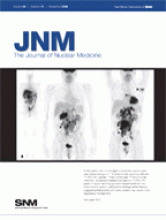TO THE EDITOR: Distant metastases are found at diagnosis or during follow-up in 10%–15% of patients with differentiated thyroid cancer. Bone is the second most commonly involved site. Patients with bone metastases, whether isolated or associated with lung metastases, have a markedly poor prognosis. Ten-year survival rates range from 13% to 21% (1).
Given such poor prognosis, the use of 131I therapy has been questioned (2). However, it might well be that poor prognosis of bone metastases can be overcome if 131I therapy is delivered at an early stage, when tumor burden is small, as previously demonstrated for pulmonary metastases (3–5).
A review of a large series of patients showed that only rarely were bone metastases diagnosed at an early stage. Among 109 patients with bone metastases reported by Bernier et al., only 4 had both radioiodine uptake and a negative standard radiography examination (1). Similarly, Durante et al. reported that only 8 of 115 patients had negative radiography findings at presentation (5).
Prognosis may improve if bone metastases are detected earlier. In a recent study (6), bone metastases were first detected by 131I scanning in 8 of 16 patients, when complementary radiologic studies were negative. Six of these patients showed an excellent response to 131I therapy. Today, the nuclear medicine community is well armed for this challenge toward earlier diagnosis. Postsurgery thyroid remnant ablation is more widely used (7). The 131I whole-body scan associated with thyroid remnant ablation after thyroidectomy has a major role in early diagnosis of functioning distant metastases (3,4,6), at a time when complementary imaging techniques (CT, MRI, bone scanning) are often still showing negative findings. Early diagnosis of specific 131I-avid bone foci will be improved with the advent and generalization of SPECT/CT.
When early diagnosis is achieved, repeated 131I therapy can be effective by targeting not only visible metastases but also those still too small to be imaged. In our practice, we administer 3.7 GBq of 131I every 6 mo until the whole-body therapy scan shows negative findings. Verification of a second negative posttherapy scan a year later could be useful, especially in cases of residual serum thyroglobulin levels.
When bone metastases are visible on radiologic examination, we give activities of 5.5 GBq every 6 mo and as frequently as every 4 mo to those with more advanced disease. Optimal management should include an 18F-FDG PET scan, to potentially detect poorly differentiated disease (8). Given the poor prognosis of large bone metastases, an aggressive surgical approach would seem warranted (9,10). However, not all bone lesions are amenable to surgical excision, and additional therapy such as radiotherapy or alternative treatments by arterial embolization, percutaneous radiofrequency ablation, cementoplasty, or alcoholization can be offered.
Most patients with bone macrometastases will die from disease. Therefore, in our opinion, 131I should not be interrupted as long as metastases are still 131I-avid, whatever the cumulative activity reached. In these patients, 131I is the only opportunity to slow progression and to prolong survival. The low statistical risk of developing a late second malignancy should not restrain physicians from effectively treating the present cancer. High cumulative activities of radioiodine (>22 GBq [600 mCi]) are associated with an increased risk of leukemia (11). Rubino et al. measured an excess absolute risk of 0.8 leukemia cases per gigabecquerel of 131I and 105 person-years of follow-up. On this basis, of 100 patients with a cumulated activity of 22 GBq and followed up for 10 y, 0.2 cases of leukemia are expected. These authors also reported a link between 131I therapy and excess colorectal cancer (and also salivary glands and bone and soft-tissue sarcomas), which was not confirmed by other studies (12). On the basis of current knowledge, it would seem unjustified to withhold 131I therapy. It should be remembered that 131I therapy is well tolerated and relatively inexpensive. Very aggressive therapies are sometimes given in other types of cancers to prolong survival only a few months.
To date, there are no effective therapies for patients with disseminated poorly differentiated carcinomas, without 131I uptake, or in whom disease progresses rapidly despite 131I therapy. In these patients, new molecular targeted treatments may provide hope (13). Several trials are currently ongoing worldwide, but none of these molecules has yet entered clinical practice.
In conclusion, early 131I-based diagnosis and aggressive case-tailored 131I therapy is what nuclear physicians can best offer to patients with bone metastases of thyroid cancer.
Footnotes
-
COPYRIGHT © 2008 by the Society of Nuclear Medicine, Inc.







